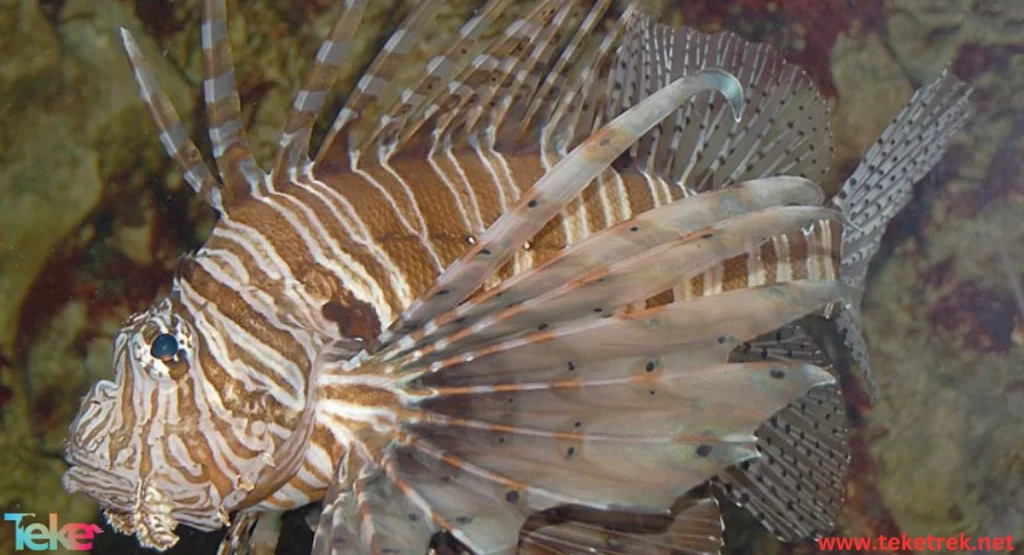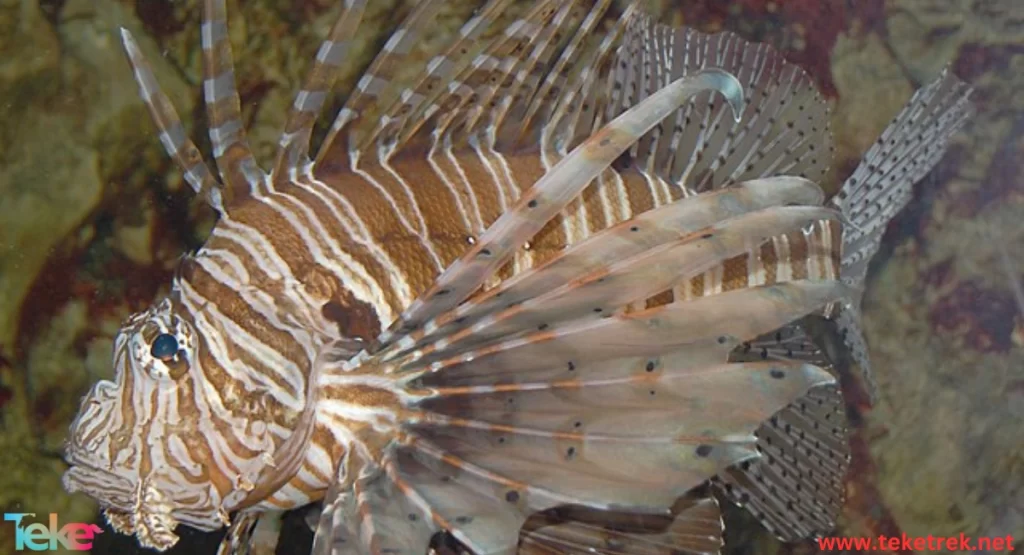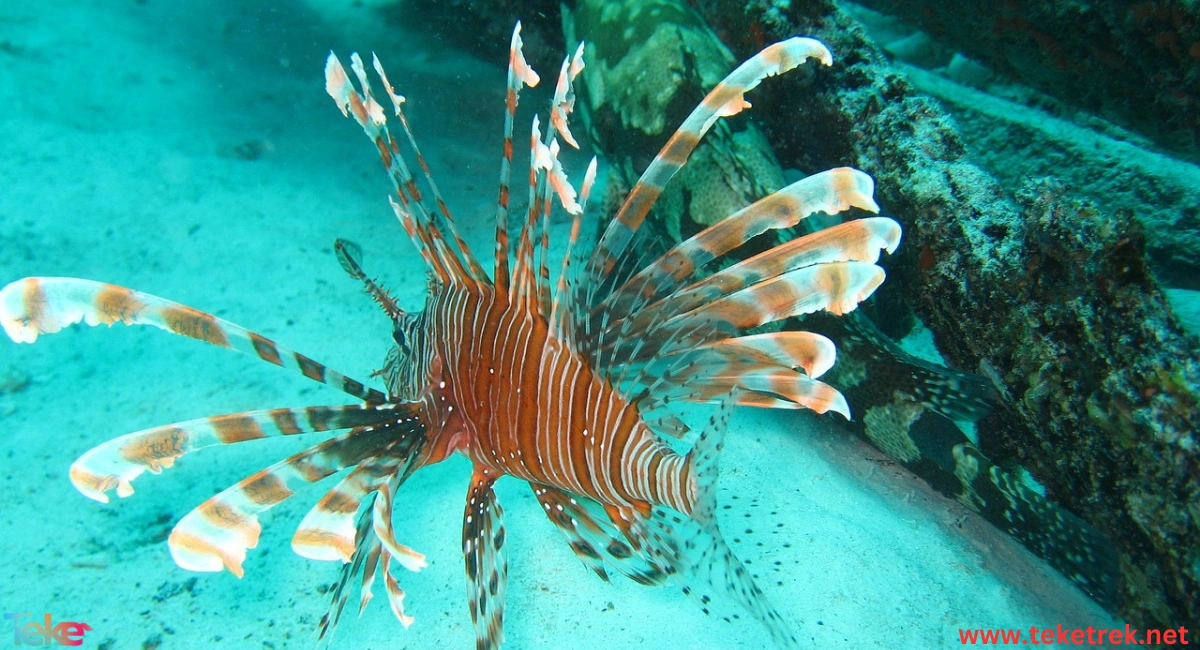Angelfish live in the coral reefs of the western Atlantic Ocean, from the Bahamas to Brazil and the Gulf of Mexico. The scientific name for angelfish is Poma canthus paru. Adult angelfish are characterized by black scales with yellow edges, while juveniles have black scales with vertical yellow stripes.
Angelfish belong to the Chordata phylum, the Vertebrata subphylum, and the Actinopterygii class.
In this article in TekeTrek Website, we will introduce you to the most important information related to this object. Follow along with us.

The external appearance of angelfish
- Angelfish have slender bodies with prominent lower jaws, small mouths, and comb-like teeth.
- Angelfish are distinguished by black scales with a bright yellow edge covering their bodies.
- Angelfish have yellow eyes on the outer part of the iris.
- Juvenile angelfish have a dark brown or black body with vertical yellow stripes.
- As juvenile angelfish mature, their scales begin to form yellow edges, while the rest of the body remains black.
- The maximum length of the gray angelfish is 60 cm, and its weight is 1.8 kg. However, these fish are more commonly observed at lengths ranging from 43-48 cm.
- The average body depth of adult angelfish is 3.3-3.5 cm.
- Maturity is reached at a length of 23 cm.
Habitats of angelfish
- Angelfish are found in coral reefs, rocky bottoms, grass flats, and other places that provide cover in tropical coastal waters.
- Angelfish have been found in the Atlantic Ocean off the coasts of Florida to Brazil.
- Angelfish also appear in the Gulf of Mexico, the Caribbean Sea, and sometimes off the coast of New York.
- These fish usually swim at a depth of 15 feet and travel in pairs in the coral reefs near sponges.
- Angelfish are strongly territorial and fight with neighboring pairs over territories.
- Due to their small bodies, angelfish can swim through narrow cracks in the coral reefs to hunt and hide from predators.
- Angelfish swim by paddling their pectoral fins, and their long tail fins allow them to turn quickly.
What do angelfish eat?
- The diet of adult angelfish consists mostly of sponges and algae. Many sponges have a V-shaped pattern due to bites from angelfish.
- Angelfish also feed on other aquatic invertebrates such as corals and bryozoans, as well as algae, detritus, and external parasites that are cleaned from other fish.
- In coral reef ecosystems, juvenile angelfish have established “cleaning stations” for a variety of fish as a way for them to control parasites. They do this by touching the fish clients’ bodies with their pelvic fins to remove parasites.
- This specialized function competes with other cleaners such as gobies and shrimp.
- Client names include wrasses, morays, surgeonfish, snappers
- Adult angelfish form pairs and stay together for life. These pairs search for food in the coral reefs during the day and hide from predators at night in the cracks in the coral reefs.
- Although angelfish are very territorial, adult angelfish are known to be very curious about divers.
- Angelfish are one of the calmest types of fish and can be kept in a community aquarium. Adults can be kept with fish of different temperaments and sizes, such as butterflyfish, fantasy grasses, as well as gobies, blennies, and other small peaceful fish.
- However, angelfish should not be placed with sedentary fish such as frogfish, seahorses, or scorpionfish, as angelfish are likely to pick them up.
Reproductive stages of angelfish
- Angelfish reach sexual maturity at about 3 years of age and a length of about 10 inches.
- Spawning occurs from April to September, unlike other fish that spawn in the open.
- Angelfish mate exclusively with their partner. The male and female angelfish travel to the surface to release their eggs into the water.
- The diameter of the eggs is only 0.04 inches, and they hatch 15 to 20 hours after fertilization.
- During each spawning event, between 25,000 and 75,000 eggs are released.
- The fish separate and return to the bottom, repeating this activity several times.
- This egg develops in plankton beds until it can descend to the coral reefs.
Frequently asked questions about angelfish
- What is the lifespan of finfish?
The life span of the vulture fish is up to 10 years.
- What do angelfish feed on?
Angelfish feed on sponges, algae, soft corals, external parasites.
- What is the suitable habitat for angelfish?
Coral reefs in tropical coastal waters.
- Can bluefish be eaten?
The spotted viper fish is caught in the Arabian Gulf countries and sold in fish markets as an edible fish.
- Do angel fish eat other fish?
Yes, they may eat smaller fish.
- Why are they called angel fish?
The reason for its name is due to its shape, which is characterized by the presence of dorsal, ventral and anal fins.


In conclusion, angelfish are of economic importance, as their young are collected using nets for sale to aquariums and breeding in captivity. Due to their high tolerance for environmental changes, resistance to diseases, and curious personalities, they are ideal for breeding in tanks.
We hope you have enjoyed this important information about angelfish.






